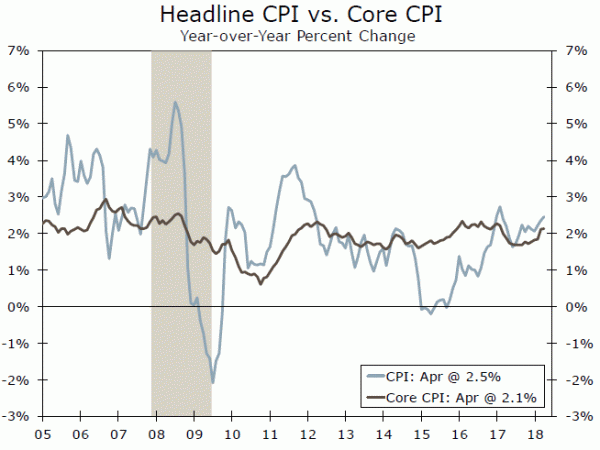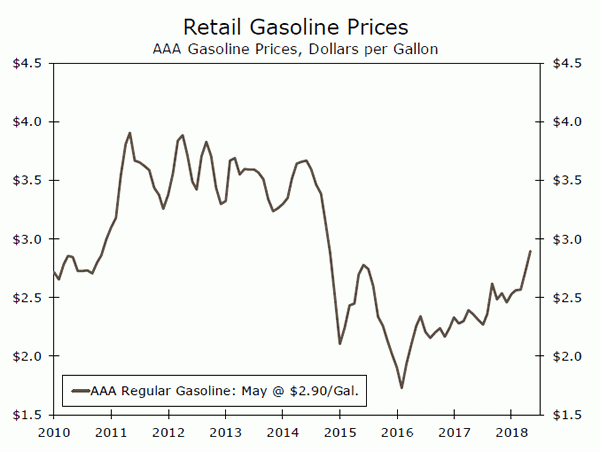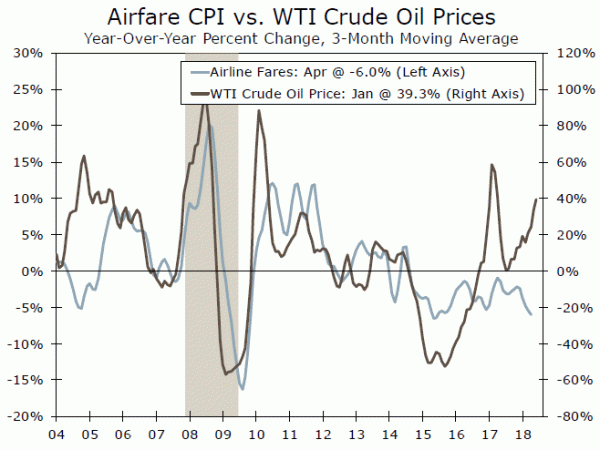After softer-than-expected readings in April, CPI is poised for a pickup in May. We expect headline CPI to rise 0.3 percent due to higher gas costs and a stronger core reading. CPI should be up 2.8 percent from a year-ago.
Ready for a Rebound
CPI inflation looks set to quickly close in on 3 percent as the FOMC kicks off its June meeting on Tuesday. We look for an above-consensus gain of 0.3 percent for May, pushing the year-over-year change up to 2.8 percent. Our model predicts the non-seasonally adjusted index rising to 251.47.
After a miss in April, core inflation should rise 0.2 percent. May will likely get a modest lift from April’s below-trend reading (0.10 percent vs. a 12-month average of 0.18 percent). Over the past five years, however, May has been a below-average month in terms of monthly gains. Therefore, we see the risks to our 0.2 percent call as fairly balanced. Year-over-year, core CPI should edge up to 2.2 percent.
What We’ll Be Watching…
Gasoline in the Driver’s Seat: Energy will be in the spotlight once again in May given the continued upward march in gasoline prices. According to AAA, gasoline prices rose 6.4 percent nationally in May. While gasoline prices typically rise this time of year as the summer driving season kicks off, last month’s increase was roughly twice as large as the average May gain over the past five years. We estimate gasoline will lift headline CPI about 5 bps in May and, with prices up more than 20 percent over the past year, contribute nearly a percentage point to the year-over-year increase in CPI.
Flying High: Airline fares fell 2.7 percent in April, which was the largest monthly drop in more than four years and pushed prices further into negative territory on a year-ago basis. We expect to see fares bounce-back in in May. Beyond the usual volatility of this line item, which makes back-toback declines of April’s magnitude look unlikely, airlines are starting to contend with higher fuel costs. Around one-third of the airline industry’s direct costs stem from fuel. Although there may be some willingness for the industry to accept lower margins, rising energy costs (alongside growing wage pressures) suggest the days are numbered for declining airline fares.
A Bumpy Ride for Vehicles: Prices for new and used autos hit a big speed bump in April. Used vehicles prices posted the largest single-month decline since the depth of the Great Recession and, when combined with a drop in new vehicles, autos shaved 6 bps off of April’s smaller-than-expected rise in headline CPI. Used auto prices are likely to remain under pressure given the high number of vehicles coming off lease, but with the Manheim Index for used vehicle pricing recovering some ground in the past two months, we doubt the extent of April’s decline as measured by the CPI will be repeated.
Turning the Dining Tables: After prices for food at home declined 1.3 percent and 0.2 percent in 2016 and 2017, the U.S. Department of Agriculture expects growth of 0.5-1.5 percent in 2018, setting up food for a greater contribution to headline CPI. Significantly above-trend price growth for food at home in April (0.3 percent gain) makes a repeat unlikely in May, but we will be watching for strength from this component in coming months.
















